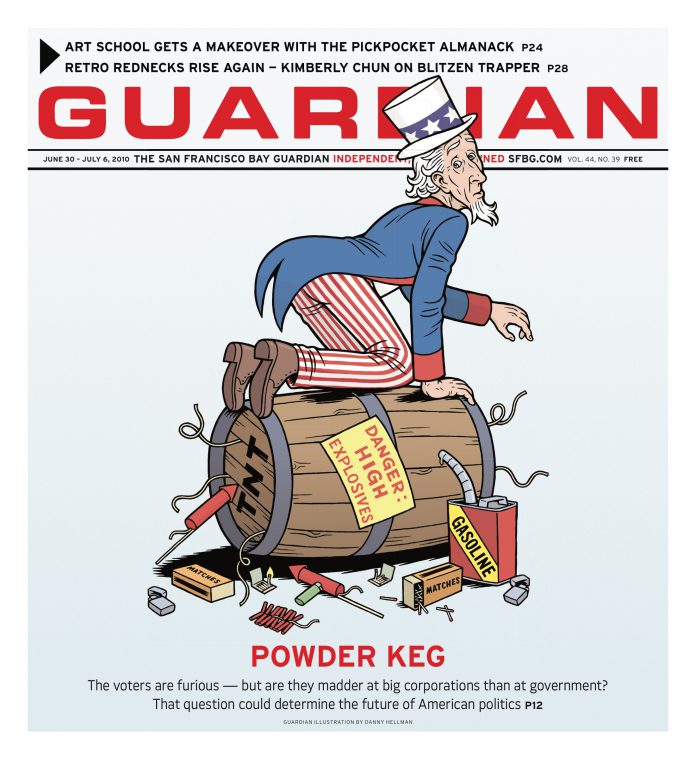arts@sfbg.com
HAIRY EYEBALL Amanda Curreri wants you. Like the open-ended phrasing of its title, "Occupy the Empty," Curreri’s second solo show at Ping Pong Gallery is both a basic statement of what an artist does within an exhibition space and a call to action soliciting the viewer to step in, step up, and take a stand. Or perhaps the phrase should be "take the stand," since, as the artist explained to me during a recent gallery visit, the arrangement of the installation’s components roughly mirrors the layout of a courtroom.
A heavy wooden bench sits to the right of the gallery entrance, evoking where the witnesses, lawyers, and spectators sit; leaning against the wall to the right is the "jury box," two long panels silk-screened with six life-size images of chairs apiece; a sculpture in the gallery’s center, which looks like a segment of the kind of pearl necklace both Jackie O and a porn actress would wear, becomes the balustrade that typically separates the actors from the observers in legal proceedings.
On the wall opposite the bench hangs a canvas covered in carefully painted grayscale rectangles — an abstract approximation of TV static — that’s next to a TV set elevated on a stool off of which hangs a compilation of last words of various famous figures (it’s hard to top Karl Marx’s final trump card: "Last words are for fools who haven’t said enough"). This is what Curreri refers to as the "power spot" in the room, "either where the judge would go or where the witness stand would be."
Our conversation is occurring after I’ve just "stepped down" from being videotaped by Curreri, and her telling collapse of the judge’s bench and the jury box sums up my experience: I wasn’t really under oath, but I wanted to be true to myself, since my act of testifying and its record are now part of "Occupy the Empty." She’s been asking people who come by the show to sign up and share their thoughts on the subject of last words. On July 9th, just before the exhibit closes, these conversations will be played back on the TV set, which until then has remained off.
Curreri started formulating "Occupy the Empty" last year after participating in a court hearing in Massachusetts concerning her late father. It turns out this was the same courthouse in which Italian-American anarchists Sacco and Vanzetti were sentenced to death in the early 20th century. Curreri, also of Italian-American descent, started thinking about the judicial system as a kind of democratic theater in which one’s mandatory performance carries incredibly high stakes — including, as with Sacco and Vanzetti and thousands of other tragic cases, death.
"I wanted to bring some gravity into what we do as artists," Curreri explains, reflecting on the stakes of participation in her art. "I really value the way people put their lives together and present themselves. So I wanted a work that would necessitate some commitment on the viewers’ part."
When Curreri starts remembering the conversation she had with her father on his deathbed, I think of the collage hanging on the wall opposite the silk-screened jury box, in which Curreri has surrounded a copy of the moving letter Sacco wrote to his son on the eve of his execution with childhood photos of her and her dad. This fusion of the personal with the historic is simultaneously touching and troubling (Sacco’s words are not those of Curreri’s father, even though the two men are aligned graphically), but it is rooted in the common impulse to ground our present by finding solace in the past. Last words are comforting in this regard. They are epigrammatic reminders that we will have our say.
At its core, "Occupy the Empty" is about just that: having a say. Or as Curreri phrases it: "I’m asking people to stand in a moment of silence and occupy it and project."
MORE FAMILY MATTERS
"3+3," a group show of local marquee names at Haines Gallery, contains a lot of eye candy. Shaun O’Dell’s delicate ink-on-paper exercises in moiré pattern interference and Leslie Shows’ graphic reconfiguration of a brush-painted Chinese landscape scroll via cut-out comics and Benday dot sprays are particularly lovely stations in this curatorial relay: Haines selected O’Dell along with Kota Ezawa and Darren WatersTon, who in turn chose Emily Prince, Taha Belal, and Shows, respectively.
Prince’s contribution stands out because the beauty of its craft comments on the nature and history of its craft. In two identical wooden square frames hang what appear to be identical lace doilies, although the one of the right seems more brittle and aged. Closer inspection reveals that the second doily is in fact a to-scale, scanned, and intricately cut-out paper replica of the one on the left, which the wall card indicates was crocheted by the artist’s grandmother. Prince’s handiwork is no less delicate — or "auratic" for that matter — than that of her grandmother’s, and this tribute to "women’s work" is no less genuine for containing a facsimile.
If you want to have a conversation about the place of craft within fine art, you’re first going to have to navigate through these two skeins.
OCCUPY THE EMPTY
Through July 10, free
"Last Words" viewing party July 9 , 7–9 p.m.
Ping Pong Gallery
1240 22nd St, SF
(415) 550-7483
3+3
Through July 10, free
Haines Gallery
49 Geary, SF
(415) 397-8114

